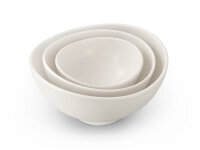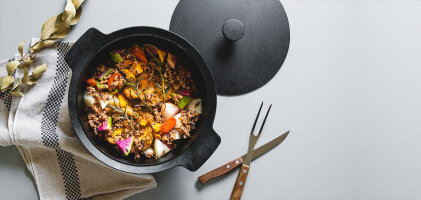Buddha Bowl Recipes - Dining Like a Monk

Today, almost everyone wants to eat "right." But that's not so easy – is it? Just take a cue from Japanese monks and experience the principle of Oryoki with the Buddha Bowl.

Eat like a monk
What is mindful eating, and what does it entail? Every expert will tell you something different, and it can be quite overwhelming. However, eating healthily and conscientiously can be delightfully simple. An example of this is the Buddha Bowl: a small bowl with various plant-based ingredients that has garnered many fans worldwide and has an interesting history. It is also called the Oryoki Bowl and perfectly embodies this principle: Not only does this term describe the dietary culture of Buddhist monks, but it also signifies "just enough, appropriate" and the mindfulness associated with the Buddha Bowl.
The Buddha Bowl is not directly related to Buddha. However, in Japan, there is a special version of Buddhist cuisine: Shojin Ryori, which can be translated as "disciplined cooking." Here, only fresh, seasonal vegetables are used, prepared with care. In Buddhist temples, monks cultivate these ingredients themselves. The avoidance of animal products and imported foods aims to establish a connection with nature and to honor life, which, in Buddhist belief, possesses a soul in all its forms.
At the same time, the ingredients are carefully selected to create a varied taste experience and a harmony of textures. The spiciness of ginger and radish, the umami of mushrooms, the crispiness of lotus root, the mild tenderness of white tofu, and the aroma of roasted sesame seeds make a Shojin Ryori dish truly unique. Add to that a seaweed-based broth, providing an umami note to the whole dish, and some soft Japanese rice that optimally absorbs the different flavors, and you have an authentic Japanese Buddhist dish. Besides the spiritual aspect, such a cuisine is delicious and easily digestible, and it is said to bring the body into balance.
Buddha also ate from a bowl
This principle can also be applied to the Buddha Bowl. The difference: Instead of eating separately in small bowls, everything is mixed in a large bowl. Buddha Bowls often consist of a grain base such as millet, quinoa, or rice, and numerous ingredients that contribute proteins and vitamins in the form of green leafy and other vegetables. "Bowl food" is not an invention of the Japanese: From simple stews to Korean Bibimbap and Mexican chili, the whole world enjoys its meals from these containers. Whether as porridge, acai bowl, or donburi – the bowl has gained a high status in modern culinary culture.
You don't have to convert to Buddhism or overhaul your lifestyle; you just need to regularly become aware of what you're actually eating and what it does to your body and the environment. The Buddha in the name comes from the mindfulness, balance, and connection to nature that define the religion. There is another version of how the bowl got its name: Buddha is said to have walked through the streets of the village where he was at the time every morning, collecting donations from the residents. They gave him small meals in a bowl that he carried with him.
Instead of representing renunciation and monotony, today the Buddha Bowl stands for creativity and the enjoyment of the moment. The recipe is simple: Take ingredients that you like and that make you full and happy. With proteins, vitamins, and whole grains, the Buddha Bowl takes care of the rest. As we already know from Bento, it's especially enjoyable when the ingredients are as colorful and diverse as possible but still complement each other well. This is not magic but simply requires a bit of experimentation. The colorful mix not only pleases the eye but also ensures that we absorb as many nutrients as possible. The principle of Buddha Bowls is: Too much of one thing is harmful, but a bit of everything is the key to health.

Light and delicious: what goes into a Buddha Bowl?
How can one get full just from plants? Raw or cooked vegetables are only part of the recipes. Many fill their Buddha Bowl with amaranth, quinoa, buckwheat, whole grain rice, or millet – all wholesome foods that satisfy for a long time and hardly contribute to weight gain. Almost all Buddha Bowl recipes are low-carb recipes and therefore suitable for weight loss. Additionally, edamame beans, tofu, avocado, and sesame seeds are reliable sources of protein. If all of this seems a bit bland to you: Don't forget your favorite herbs and spices. Or how about a light, tasty sauce?
In the last few years, the Buddha Bowl has also become a food trend in our part of the world. No wonder: With its colorful mix of wholesome ingredients, it is not only pleasing to the eye but also nourishing and soothing for the body. Easily digestible, quickly cooked, and long-lasting in satiety, the Buddha Bowl challenges any sandwich or pasta plate for the position of a quick lunch on a busy workday. Not only are the bowls quickly prepared, but the variety of recipes and variations also keeps it from becoming boring.
We have found that there are countless ways to prepare Buddha Bowls – whether simple or elaborate, hearty or light. This is evidenced by pictures and recipes in numerous food blogs, whose authors are enthusiastic about the new way of cooking. Although the Buddha Bowl is essentially vegan, certain variations may include ingredients such as feta, eggs, and lean chicken – each according to personal taste. If you want to get to know the bowl or are not sure where to start, we have a few Buddha Bowl recipes and tips for you. All you need is one thing above all: a beautiful bowl.
Buddha Bowl recipe: The protein bomb, chickpeas with peanut sauce
 2 personsNo. of persons
2 personsNo. of persons
 ca. 45 minutesTotal Time
ca. 45 minutesTotal Time
 easyLevel of difficulty
easyLevel of difficulty
 main mealDish
main mealDish
 ca. 900kcal per portionCalories
ca. 900kcal per portionCalories
 Vegetarian
Vegetarian
 Fish
Fish
 Kitchenware
Kitchenware
|
100g
cooked chickpeas
|
|
1/2
baked sweet potato
|
|
75g
fresh or smoked tofu
|
|
50g
sugar snap peas
|
|
1
small, colorful head of lettuce (e.g. radicchio or lollo rosso)
|
|
1
Tomato
|
|
Roasted sesame seeds
|

|
200g
fresh peanuts
|
1
garlic clove
|
|
1
chili pepper
|
1/2
Shell
|
|
0,5cm
ginger
|
3 tbsp
sesame oil
|
|
1 tsp
brown sugar
|
50ml
coconut milk
|
|
20ml
Soy sauce
|
1
Lime
|
|
Salt
|
Pepper
|
|
Paprika powder
|
|

Buddha Bowl recipe: Wholesome rice variation with plum sauce
 2 personsNo. of persons
2 personsNo. of persons
 ca. 45 minutesTotal Time
ca. 45 minutesTotal Time
 easyLevel of difficulty
easyLevel of difficulty
 main mealDish
main mealDish
 380kcal per portionCalories
380kcal per portionCalories
 Vegetarian
Vegetarian
 Lactose-free
Lactose-free
 Alcohol
Alcohol
 Kitchenware
Kitchenware
|
50g
whole grain rice
|
|
50g
cooked edamame beans (alternatively kidney beans or peas)
|
|
100g
green cabbage or Brussels sprouts
|
|
1/2
zucchini
|
|
1
small red bell pepper
|
|
1
carott
|
|
20g
walnuts (or other nuts to taste)
|

|
1
garlic clove
|
|
1/4
peppercorns
|
|
2
cloves
|
|
1
chili pepper
|
|
70g
sugar
|
|
1cm
ginger
|
|
75ml
red wine vinegar
|
|
250g
plums
|
|
1/4 tsp
each aniseed and cinnamon
|
|
1 tsp
soy sauce
|
Buddha Bowl recipe: Colorful and fresh, rainbow bowl with quinoa
 2 personsNo. of persons
2 personsNo. of persons
 ca. 45 minutesTotal Time
ca. 45 minutesTotal Time
 easyLevel of difficulty
easyLevel of difficulty
 main mealDish
main mealDish
 250kcal per portionCalories
250kcal per portionCalories
 Vegetarian
Vegetarian
 Gluten-free
Gluten-free
 Kitchenware
Kitchenware
|
50g
Quinoa
|
|
1/2
Avocado
|
|
1
carott
|
|
1/4
cucumber
|
|
1
yellow bell bell pepper
|
|
50g
fresh baby spinach
|
|
1-2
Radish
|
|
Roasted sesame seeds to taste
|

|
3cm
fresh ginger
|
|
1
garlic clove
|
|
1 tbsp
soy sauce
|
|
2 tbsp
lime juice
|
|
1 tbsp
white miso paste
|
|
4 tbsp
sesame oil
|
|
2 tbsp
neutral oil
|
|
4 tbsp
water
|
A wholesome meal in a bowl: Creating a Buddha Bowl is as simple as that. As lunch for a busy workday, the bowl can be prepared the day before and taken along. Moreover, it can be turned into a wonderful leftover meal with everything that's currently in the fridge. Practice mindfulness and unleash your creativity as you eat just as much as fits in your bowl – that's part of the Oryoki principle.



















-from-the-yakiyaki-grill-pan.jpg)




